Moroccan couscous with roasted veg and tahini dressing is a healthy and affordable vegetarian-friendly meal that is bursting with color and Mediterranean flavors. This easy couscous recipe combines plenty of roast veg seasoned with cumin, and garlic and laid on a bed of couscous.
The colorful turmeric-infused couscous also gets a boost of flavor with plenty of chickpeas, raisins, and freshly chopped parsley. Add some fresh summer stone fruit or dried apricots for some extra sweetness. Topped with a tangy homemade tahini dressing, this is the perfect meal or side dish.
Table of contents:
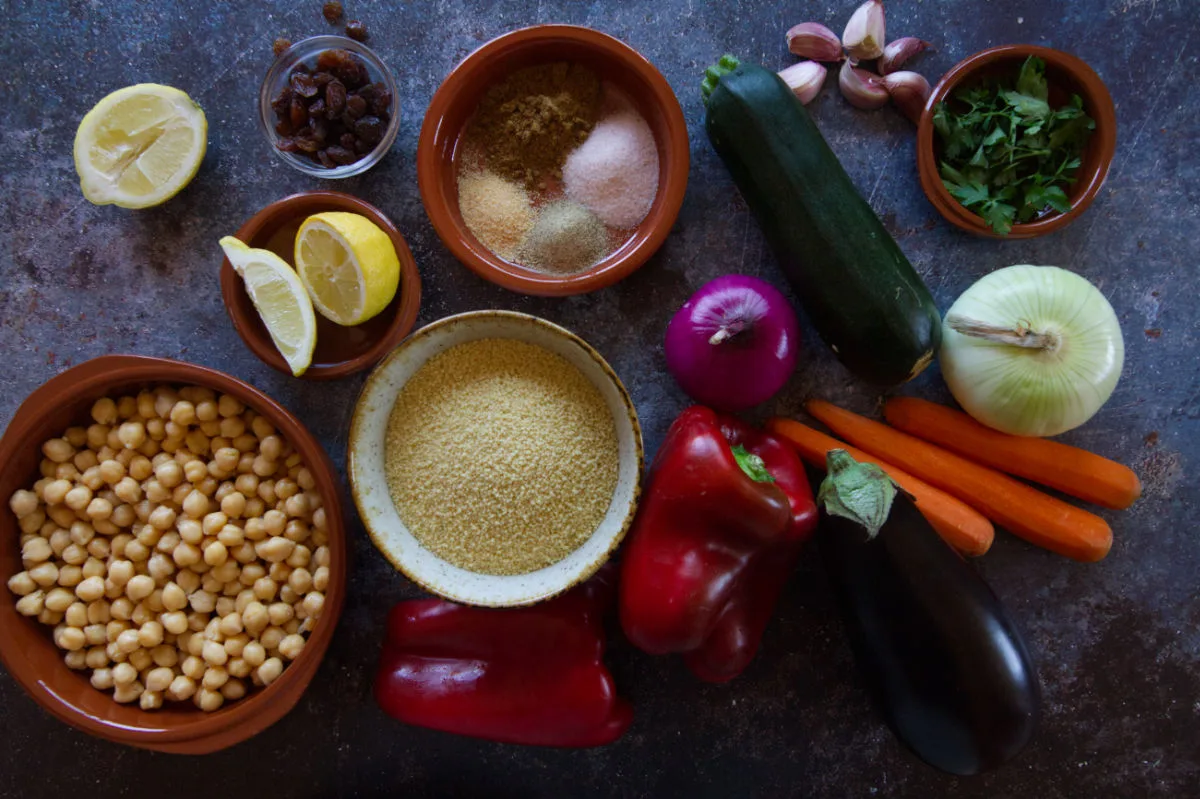
How to Make Moroccan Couscous with Roasted Veg and Tahini Dressing
Ingredients
For the Roast Veggies
- 1 medium zucchini
- 1 small eggplant
- 1 large red bell pepper
- 3 small carrots
- 1 medium-sized red onion
- 1 medium-sized white onion
- 1 heaped teaspoon of ground cumin
- ½ teaspoon of white pepper
- ½ teaspoon of garlic powder
- ½ teaspoon of salt
- 4 tablespoons of extra virgin olive oil
For the Couscous
- 1 & 1/3 cups of dry couscous (we used instant couscous)
- 2-3 cups of vegetable stock
- 1 teaspoon of ground turmeric
- 2 tablespoons of raisins
- 2 tablespoons of dried apricots (cut into small pieces)
- 14 oz / 400 grams of cooked chickpeas, drained and rinsed
For the Homemade Tahini Dressing
- 1/3 cup of tahini paste
- 1 lemon, juiced
- 2 tablespoons of honey
- Water ~3-6 tablespoons (1.5-3 fl oz. / 45-90 ml)
- Salt (to taste)
Equipment
- Chopping board
- Sharp knife
- Plate or tray
- A kitchen towel or foil
- Large baking tray
- Oven
- Small bowl
- Whisk
Instructions
Step 1 – Prepare Roast veggies
- Preheat oven to 450°F/232°C.
- Cut your veg into bite-sized pieces and lay them onto a large baking tray.
- Pour the olive oil over the veg and cover them in the spices.
- Mix by hand to ensure veg are evenly covered.
- Add a good squeeze of lemon juice, season to taste with salt and pepper, and bake for 25 minutes. (if you want your veg to crisp up slightly, add them to the top shelf of the oven for the last few minutes of cooking.
Step 2 – Prepare the Couscous
- Bring the vegetable stock to a boil. Take it off the heat and add one teaspoon of ground turmeric and stir. Note: we used instant couscous which is the most commonly found in countries like the US and UK. If you’re using traditional couscous see our notes below on “how to cook couscous.”
- Pour the couscous into a large flat dish or tray and give the tray a little shake to even out the couscous. Add enough vegetable stock to cover the couscous completely.
- Cover with a kitchen towel or some aluminum foil and let rest for 5 minutes. The couscous will cook and expand to around double the size.
- Add the raisins, chickpeas, and some freshly chopped parsley. Mix well and set aside for use later.
Step 3 – Make Tahini Dressing
- Add tahini paste, lemon juice, and honey to a small bowl and whisk.
- Slowly add water until creamy and it reaches the desired consistency. Add a little salt to taste.
What is The History of Moroccan Couscous?
Moroccan couscous has a fascinating history that is rooted in North African culture. Couscous is a traditional dish made from steamed semolina wheat granules, typically served with a stew of vegetables, meat, or fish. Its origin can be traced back thousands of years, and its preparation and significance have evolved over time.
Today, Moroccan couscous remains a beloved dish, representing the region’s rich history and diverse culinary heritage. It has also gained popularity worldwide, delighting people from various cultures with the delicious flavor combinations it can be paired with and unique texture.
Ancient Origins of Couscous
Couscous is believed to have originated in the Berber regions of North Africa, which includes present-day Morocco, Algeria, Tunisia, and Libya. The Berbers — indigenous people of North Africa — have been cultivating wheat and making couscous since ancient times.
Couscous has been a staple food in Berber culture for thousands of years, well before the arrival of Arab influences in the 7th century. The dish was not only a dietary mainstay but also played a crucial role in Berber social and cultural practices. It was often prepared during special occasions, festivals, and gatherings, symbolizing hospitality and togetherness.
With the Arab conquest of North Africa in the 7th century, Arabic influences began to shape Moroccan cuisine, including couscous. The preparation and flavors of couscous expanded as spices like saffron, cinnamon, cumin, and ginger were introduced. The use of meat in couscous dishes — particularly lamb — also became more prevalent.
Spread of Couscous Beyond North Africa
Over time, couscous spread beyond North Africa to the Mediterranean region including Spain and Italy, and through to other parts of Europe. It’s also very popular in the Middle East.
In modern-day Morocco, couscous remains a cherished and essential part of Moroccan cuisine. While it is still a traditional dish in rural areas, it has also become more widely available in urban centers and international restaurants.
In the Islamic calendar, couscous dishes and recipes are often prepared on Fridays, a special day calendar, and during festive occasions like weddings and religious celebrations.
UNESCO Recognition of Couscous
In 2010, couscous was inscribed by UNESCO on its list of endangered intangible cultural heritage. This recognition highlights the importance of couscous as a cultural symbol and tradition in North African societies.

Types of Couscous
There are typically two types of couscous available: traditional couscous and instant couscous.
- Traditional Couscous: Traditional couscous is the coarser variety that requires longer cooking time and a more involved preparation process.
- Instant Couscous: Instant couscous is pre-cooked and then dehydrated, making it a quicker option to prepare.
How to Cook Couscous
The cooking time for couscous depends on the type of couscous you are using. We used instant couscous for this recipe as it is what’s most commonly found in supermarkets where we live in Spain. It’s also pretty common to find ‘Instant couscous’ in stores in the US, the UK, and Australia.
It’s essential to follow the instructions on the couscous packaging as cooking times may vary slightly based on the brand and type of couscous, so check before purchasing.
Regardless of the type, couscous is generally quick and easy to prepare, making it a convenient choice for many dishes.
Here’s a general guideline for cooking traditional couscous:
- Bring water or broth to a boil in a pot, using a ratio of 1.5 cups of liquid for every 1 cup of couscous.
- Once the liquid comes to a boil, remove the pot from the heat and stir in the couscous.
- Cover the pot with a lid and let the couscous sit for about 5 to 10 minutes, allowing it to absorb the liquid and steam.
- After 5 minutes of resting time, fluff the couscous with a fork to separate the grains.
Here’s a general guideline for cooking instant couscous:
- Ladle some boiling water (or stock) onto a plate or tray of couscous. Note: the flatter the plate the better. Use just enough water to cover the couscous.
- The typical ratio of water to instant couscous is 1:1.
- Cover the couscous with a lid and let it sit for about 5 minutes.
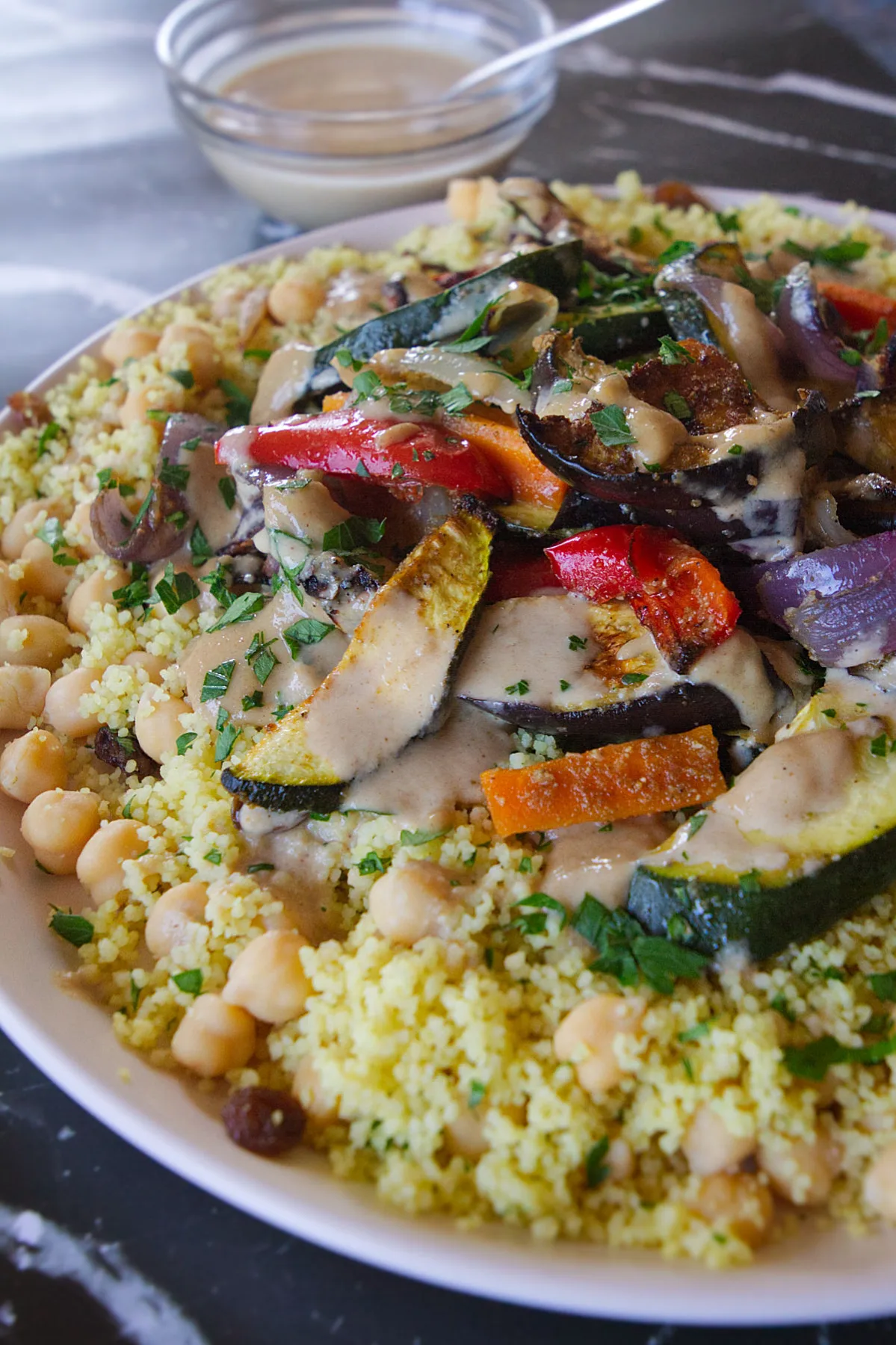
Best Vegetables to Roast With Couscous
Use fresh seasonal vegetables whenever possible. They will be cheaper to buy and are better for the environment (especially if they are grown locally) and your health since they’re usually fresher. Fresh veggies also have the added benefit of more flavor.
For this recipe, we used some easy-to-find Mediterranean staples that are common in most countries:
- 1 medium zucchini
- 1 small eggplant
- 1 large red bell pepper
- 3 small carrots
- 1 medium-sized red onion
- 1 medium-sized white onion
Veggie Substitutions
Come wintertime, use pumpkins or sweet potatoes for a more filling roast veggie plate. During the warmer months, plump roasted tomatoes and green beans are great in the oven.
Tahini Dressing
Tahini is a paste made from ground sesame seeds and is appreciated for its nutty flavor, creaminess, and versatility in both sweet and savory dishes. It has a long history that dates back thousands of years and originated in the Middle East and Mediterranean regions. Tahini has been a staple ingredient in various cuisines and traditional dishes ever since the cultivation of sesame seeds, which are thought to have been one of the oldest oilseed crops known to humanity.
Sesame seeds have been cultivated in regions of the Middle East and the Indian subcontinent for thousands of years. Archaeological evidence suggests that sesame seeds were domesticated in the Indus Valley around 5,000 years ago.
Mesopotamian and Egyptian Use of Tahini
Ancient civilizations, such as the Sumerians and Babylonians in Mesopotamia, are believed to have used sesame seeds to make oil. In ancient Egypt, sesame seeds were pressed to extract oil, which was then used for cooking and as a base for cosmetics.
Trade and cultural exchanges flourished and sesame seeds and tahini spread across the Middle East and Mediterranean regions. The use of tahini in food became widespread in the Levant (modern-day Syria, Lebanon, Israel, Palestine, and Jordan), Greece, Turkey, and other neighboring countries.
Nowadays, tahini is a staple in Middle Eastern and Mediterranean Cuisine. It has become a fundamental ingredient where it is used in various dishes and sauces everywhere from Egypt and Greece, to Lebanon, and Morocco.
Tahini serves as a base for popular recipes you may know and love already such as hummus, baba ganoush, halva, and various salad dressings.
The Global Popularity of Tahini
With the spread of Middle Eastern and Mediterranean cuisines around the world, tahini has gained international popularity and is readily available in most grocery stores today.
We make a super easy tahini dressing for this recipe that uses just 5 ingredients (tahini paste, lemon, honey, water, and salt) and is ready in around 2 minutes from start to finish. We think you’ll be pouring this over more than couscous dishes once you’ve tried it too — it also goes great over certain salads and quinoa dishes too.
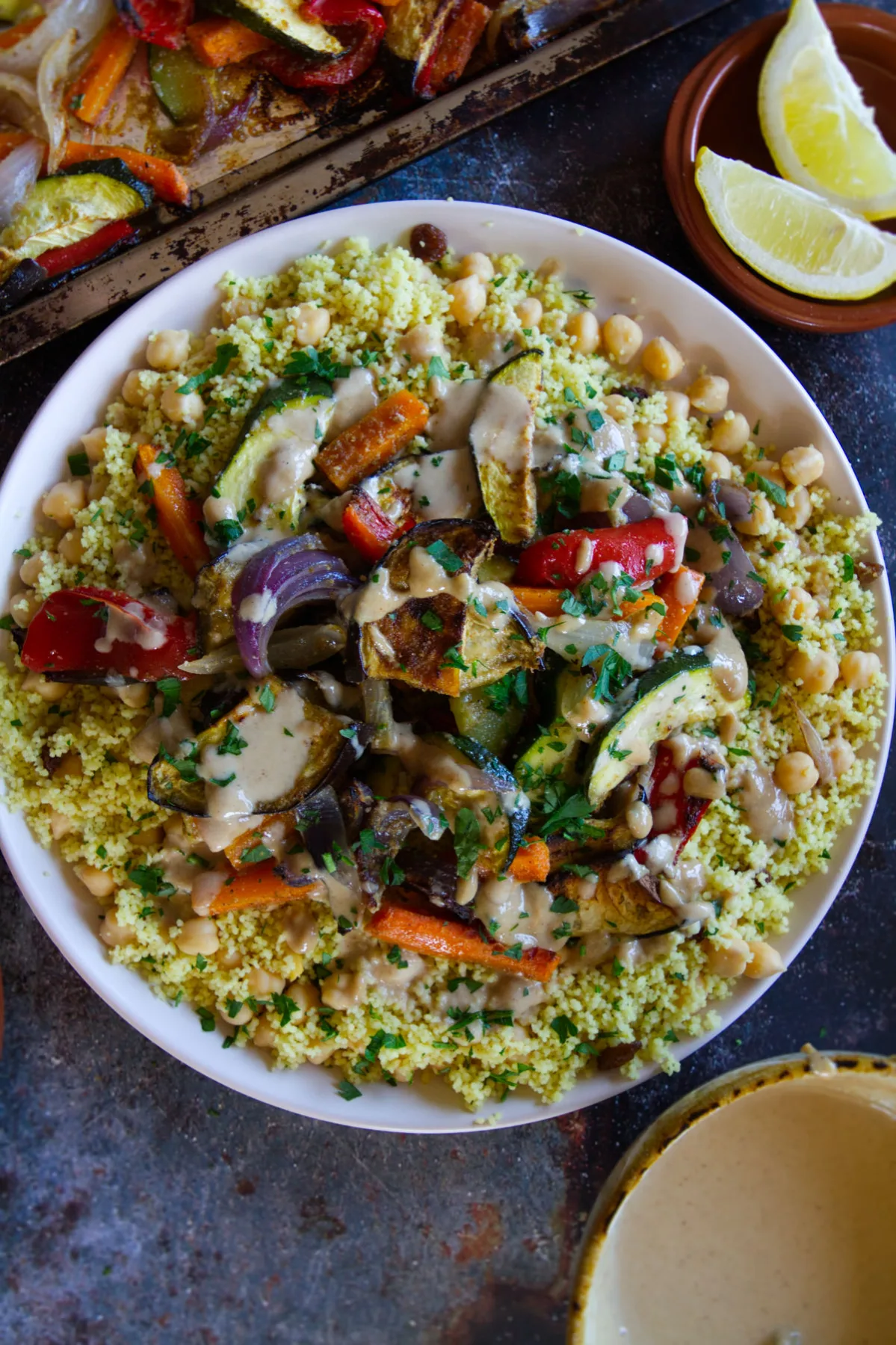
FAQs and cooking tips
What is Moroccan Couscous Made Of?
It’s made from semolina flour (semolina is a type of flour made from durum wheat) and water.
How Long Does Instant Couscous Take to Cook?
5 minutes. Here are the steps required to cook light and fluffy instant couscous:
- Ladle some boiling water (or stock) onto a plate or bowl of couscous. Note: the flatter the plate the better. Use just enough water to cover the couscous.
- Cover the couscous with a lid and let it sit for about 5 minutes.
Is Couscous Gluten-Free?
No, couscous is made from Durum wheat and is not gluten-free.
Is Couscous Healthy?
Yes, couscous is healthy. It is high in fiber which has been proven to reduce cholesterol and the risk of heart disease. Couscous contains less calories than rice or quinoa, with one cup of couscous containing less than 200 calories.
Where is Tahini From?
The Middle East. Nowadays, tahini is a Staple in Middle Eastern and Mediterranean cuisine and can be found in most grocery stores or supermarkets.
| Nutrition Facts | |
| Servings: 6 | |
| Amount per serving | |
| Calories | 558 |
| % Daily Value* | |
| Total Fat 11.9g | 15% |
| Saturated Fat 1.5g | 7% |
| Cholesterol 0mg | 0% |
| Sodium 286mg | 12% |
| Total Carbohydrate 95.6g | 35% |
| Dietary Fiber 20g | 72% |
| Total Sugars 22g | |
| Protein 22.5g | |
| Vitamin D 0mcg | 0% |
| Calcium 170mg | 13% |
| Iron 7mg | 37% |
| Potassium 1138mg | 24% |
| *The % Daily Value (DV) tells you how much a nutrient in a food serving contributes to a daily diet. 2,000 calorie a day is used for general nutrition advice. | |

Moroccan Couscous With Roasted Veg And Tahini Dressing
Equipment
- Chopping board
- Sharp knife
- Plate or tray
- A kitchen towel or foil
- Large baking tray
- Oven
- Small bowl
- Whisk
Ingredients
For the roast veggies
- 1 medium zucchini
- 1 small eggplant
- 1 large red bell pepper
- 3 small carrots
- 1 medium-sized red onion
- 1 medium-sized white onion
- 1 heaped teaspoon of ground cumin
- ½ teaspoon of white pepper
- ½ teaspoon of garlic powder
- ½ teaspoon of salt
- 4 tablespoons of Extra virgin olive oil
For the couscous
- 1 & 1/3 cups of dry couscous we used instant couscous
- 2-3 cups of vegetable stock
- 1 teaspoon of ground turmeric
- 2 tablespoons of raisins
- 2 tablespoons of dried apricots cut into small pieces
- 14 oz / 400 grams of cooked chickpeas drained and rinsed
For the homemade tahini dressing
- 1/3 cup of tahini paste
- 1 lemon juiced
- 2 tablespoons of honey
- Water ~3-6 tablespoons 1.5-3 fl oz. / 45-90 ml
- Salt to taste
Instructions
Step 1 – Prepare Roast Veggies
- Preheat oven to 450°F/232°C.
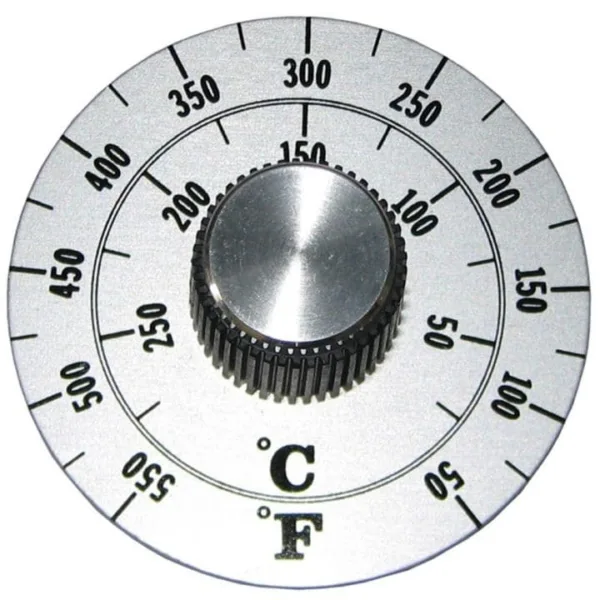
- Cut your veg into bite-sized pieces and lay them onto a large baking tray.
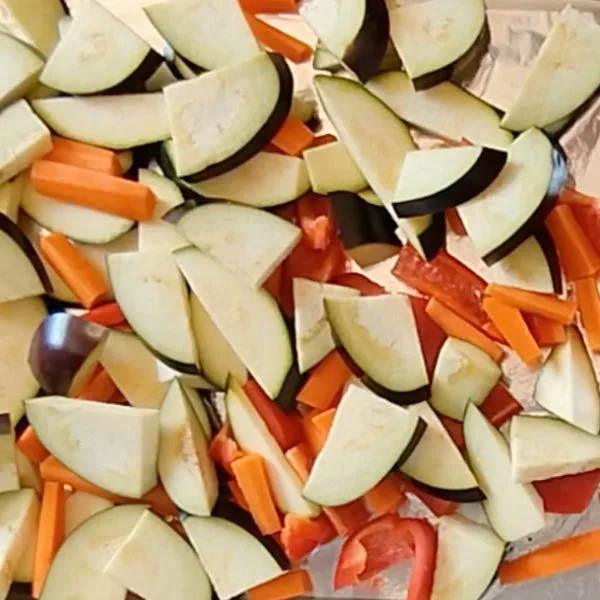
- Pour the olive oil over the veg and cover them in the spices. Mix by hand to ensure veg are evenly covered.
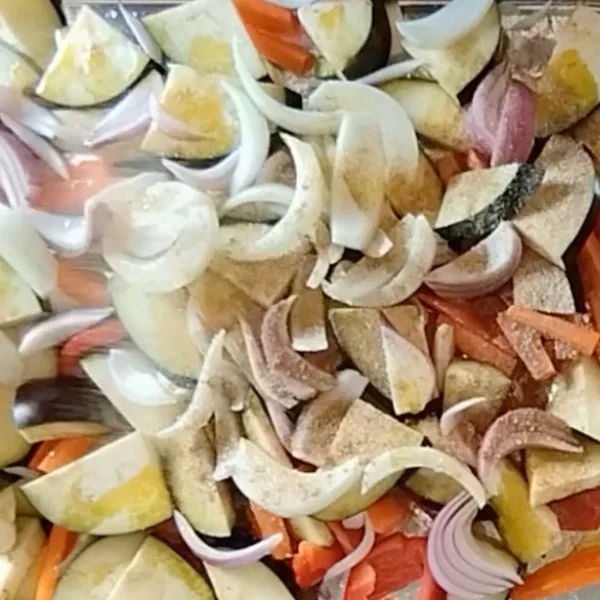
- Add a good squeeze of lemon juice, season to taste with salt and pepper, and bake for 25 minutes. (if you want your veg to crisp up slightly, add them to the top shelf of the oven for the last few minutes of cooking.
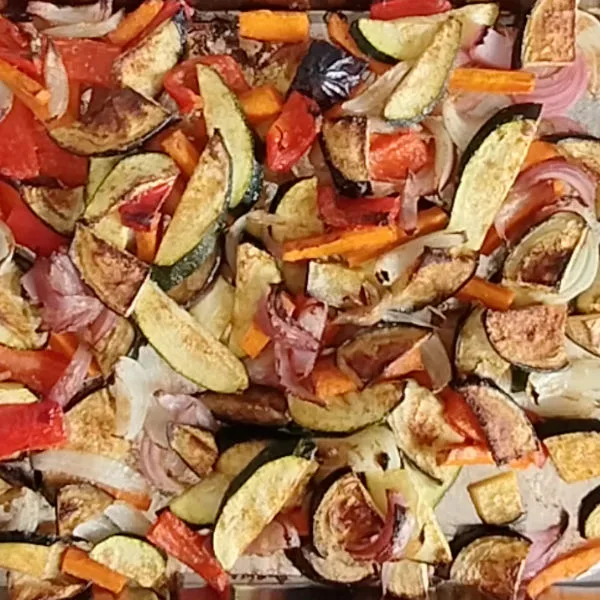
Step 2 – Prepare the Couscous
- Bring the vegetable stock to a boil. Take it off the heat and add one teaspoon of ground turmeric and stir.

- Pour the couscous into a large flat dish or tray and give the tray a little shake to even out the couscous. Add enough vegetable stock to completely cover the couscous.

- Cover with a kitchen towel or some aluminum foil and let rest for 5 minutes. The couscous will cook and expand to around double the size.

- Add the raisins, chickpeas, and some freshly chopped parsley. Mix well and set aside for use later.
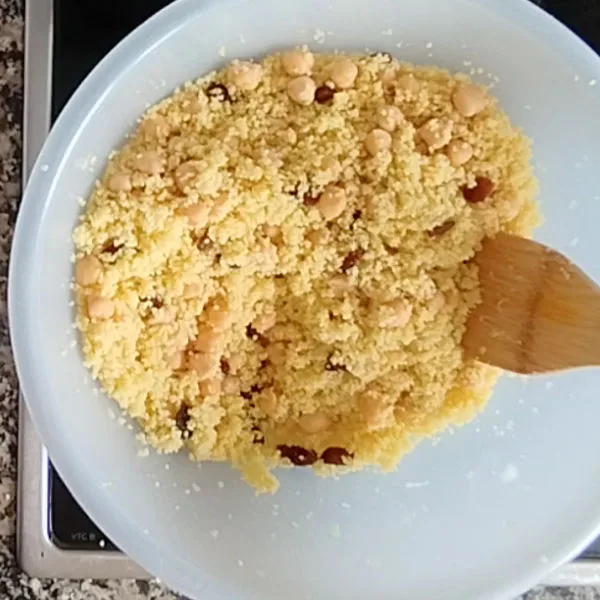
Step 3 – Make Tahini Dressing
- Add tahini paste, lemon juice, and honey to a small bowl and whisk. Slowly add water until creamy and it reaches the desired consistency. Add a little salt to taste.



Leave a Reply